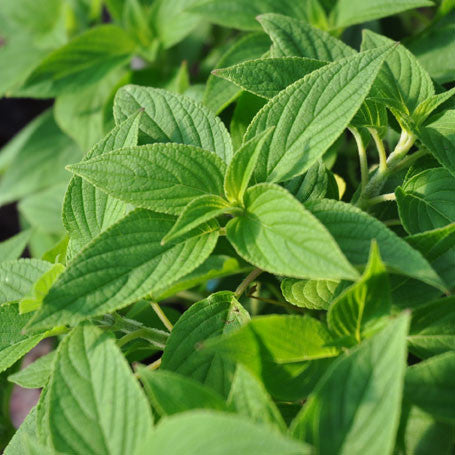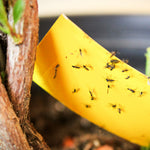Five Ways to Prevent Bringing Pests Indoors

If there is one reason gardeners hesitate to bring plants indoors from the patio or summer garden, it relates to stress about bringing pests indoors at the same time. This is very understandable; pests can undermine the satisfaction and enjoyment of being surrounded by greenery through winter.
The really good news is that there are easy, organic strategies to prevent indoor pest problems. Here are my top five:
1) Wash plants vigorously with fast flowing fresh water. Most pests that follow plants indoors occur on the undersides of upper foliage. These pest are easily dislodged by water and are often damaged by the flow. Nothing could be easier! If you are finding the water is causing soil to "splat" out of the container make a simple barrier out of an aluminium pie pan or cardboard (just make a slit to fit around the plant's main stem). It is a really good idea to follow this up on a monthly basis through winter (easy to do in the shower) indoors.
2) Trim back stem tips. Following through on the idea that pest most often occur on the upper growth, potential pest problems can be avoided by cutting plants back. A secondary benefit is that this stimulates new growth indoors. The rule of thumb is that leafy plants can be cut back dramatically (some - like - mints & parsley - benefit from cutting right down) while woody plants should only have their vegetative growth trimmed. Just like showering, it pays to do this a few times through winter.
3) Wipe down the inner and outer rim of containers. When not hiding out under the top growth many pests will make their home (in fact most often during their immature stages) around the rim of the pot. Start with warm soapy water and a soft cloth then finish things off with a wipe using 10% bleach solution or hydrogen peroxide. This can be repeated every so often through winter. If there is ever stickiness on the pot or on the floor around your indoor plants be sure to attend to this using warm soapy water and have a look for adults pests higher up on plants.
4) Take cuttings rather than bringing large plants indoors. This is not a suggestion that can always be used - but it works very well for varieties that root relatively easily and where your goal is to keep stock rather than a feature house plant.
Some prime examples of plants that do well with this method are Pineapple Sage, Lemon Verbena, Oregano, Aussie Sweetie Basil, Mint, Geraniums, Sages, Coleus, Plectranthus, Ornamental Perilla. The theme here is plants that get quite big in a single growing season (which makes them challenging to bring in and keep full).
The pest management opportunity lies in the fact that you are bringing in a very controlled portion of the plant and no soil. You can thoroughly clean/rinse the cuttings before rooting and be selective as you take the cuttings to avoid any obviously diseased sections. Rooting in fall is often as simple as placing the trimmed down cutting sections in water and remembering to change it every day.
5) Focus on pest resistant varieties. This may seem like frustrating advice... kind of like saying just eat your veggies to stay healthy (in real life it is never quite so easy). But there are definitely plants that are much better at naturally resisting pests and there are some that just attract every pest under the sun. As an example, the bedding plant Verbena is pretty much a non stop host for spider mites. Another classic example is the beautiful bedding plant Lantana. These are two plants that really require constant intervention with pesticides to stay healthy when grown indoors (or the greenhouse... and that is why we do not offer these).
On the flip side, gardener friendly selections such the succulent Haworthias, Sanseveria, Allspice, Neem, Asparagus Fern, Pregnant Onion, Coffee, Philodendron, Sugar Cane, Scented Geraniums, Lemon Grass and Winter Jasmine are all naturally less likely to get pest problems as houseplants.
The really good news is that there are easy, organic strategies to prevent indoor pest problems. Here are my top five:
1) Wash plants vigorously with fast flowing fresh water. Most pests that follow plants indoors occur on the undersides of upper foliage. These pest are easily dislodged by water and are often damaged by the flow. Nothing could be easier! If you are finding the water is causing soil to "splat" out of the container make a simple barrier out of an aluminium pie pan or cardboard (just make a slit to fit around the plant's main stem). It is a really good idea to follow this up on a monthly basis through winter (easy to do in the shower) indoors.
2) Trim back stem tips. Following through on the idea that pest most often occur on the upper growth, potential pest problems can be avoided by cutting plants back. A secondary benefit is that this stimulates new growth indoors. The rule of thumb is that leafy plants can be cut back dramatically (some - like - mints & parsley - benefit from cutting right down) while woody plants should only have their vegetative growth trimmed. Just like showering, it pays to do this a few times through winter.
3) Wipe down the inner and outer rim of containers. When not hiding out under the top growth many pests will make their home (in fact most often during their immature stages) around the rim of the pot. Start with warm soapy water and a soft cloth then finish things off with a wipe using 10% bleach solution or hydrogen peroxide. This can be repeated every so often through winter. If there is ever stickiness on the pot or on the floor around your indoor plants be sure to attend to this using warm soapy water and have a look for adults pests higher up on plants.
4) Take cuttings rather than bringing large plants indoors. This is not a suggestion that can always be used - but it works very well for varieties that root relatively easily and where your goal is to keep stock rather than a feature house plant.
Some prime examples of plants that do well with this method are Pineapple Sage, Lemon Verbena, Oregano, Aussie Sweetie Basil, Mint, Geraniums, Sages, Coleus, Plectranthus, Ornamental Perilla. The theme here is plants that get quite big in a single growing season (which makes them challenging to bring in and keep full).
The pest management opportunity lies in the fact that you are bringing in a very controlled portion of the plant and no soil. You can thoroughly clean/rinse the cuttings before rooting and be selective as you take the cuttings to avoid any obviously diseased sections. Rooting in fall is often as simple as placing the trimmed down cutting sections in water and remembering to change it every day.
5) Focus on pest resistant varieties. This may seem like frustrating advice... kind of like saying just eat your veggies to stay healthy (in real life it is never quite so easy). But there are definitely plants that are much better at naturally resisting pests and there are some that just attract every pest under the sun. As an example, the bedding plant Verbena is pretty much a non stop host for spider mites. Another classic example is the beautiful bedding plant Lantana. These are two plants that really require constant intervention with pesticides to stay healthy when grown indoors (or the greenhouse... and that is why we do not offer these).
On the flip side, gardener friendly selections such the succulent Haworthias, Sanseveria, Allspice, Neem, Asparagus Fern, Pregnant Onion, Coffee, Philodendron, Sugar Cane, Scented Geraniums, Lemon Grass and Winter Jasmine are all naturally less likely to get pest problems as houseplants.






